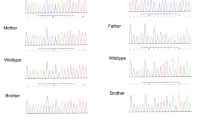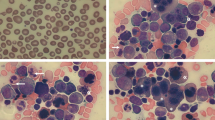Abstract
Congenital dyserythropoietic anemia type II (CDA II), a rare genetic disorder, results from SEC23B gene mutations according to previous studies. Here, we present a case of CDA II involving two novel pathogenic mutations of SEC23B that have not previously been reported. The patient suffered from jaundice, tea-colored urine, and weakness. Laboratory data indicated moderately decreased hemoglobin, iron overload, and abnormal erythroblast morphology. Therefore, a diagnosis of CDA II was considered. Peripheral blood samples were used to perform whole exome sequencing, and the results showed compound heterozygosity of the SEC23B gene with the following mutations: c.1162T>A (p.F388I) and c.1603delC (p.R535del). The mutant proteins were predicted to be deleterious and resulted in decreased structural stability. PyMOL software was used to analyze the structural change caused by the p.F388I missense mutation, and the results indicated a deficiency in π–π interactions. In conclusion, our report extends the mutation spectrum of SEC23B in the diagnosis of CDA II.

Similar content being viewed by others
Data accessibility
All study data, including raw and analyzed data and materials, will be available from the corresponding author upon reasonable request.
References
Wickramasinghe SN, Wood WG. Advances in the understanding of the congenital dyserythropoietic anaemias. Br J Haematol. 2005;131(4):431–46. https://doi.org/10.1111/j.1365-2141.2005.05757.x.
Kamiya T, Manabe A. Congenital dyserythropoietic anemia. Int J Hematol. 2010;92(3):432–8. https://doi.org/10.1007/s12185-010-0667-9.
Bianchi P, Fermo E, Vercellati C, Boschetti C, Barcellini W, Iurlo A, et al. Congenital dyserythropoietic anemia type II (CDAII) is caused by mutations in the SEC23B gene. Hum Mutat. 2009;30(9):1292–8. https://doi.org/10.1002/humu.21077.
Gasparini P, Miraglia DGE, Delaunay J, Totaro A, Granatiero M, Melchionda S, et al. Localization of the congenital dyserythropoietic anemia II locus to chromosome 20q112 by genomewide search. Am J Hum Genet. 1997;61(5):1112–6. https://doi.org/10.1086/301609.
Schwarz K, Iolascon A, Verissimo F, Trede NS, Horsley W, Chen W, et al. Mutations affecting the secretory COPII coat component SEC23B cause congenital dyserythropoietic anemia type II. Nat Genet. 2009;41(8):936–40. https://doi.org/10.1038/ng.405.
Bianchi P, Schwarz K, Högel J, Fermo E, Vercellati C, Grosse R, et al. Analysis of a cohort of 101 CDAII patients: description of 24 new molecular variants and genotype-phenotype correlations. Br J Haematol. 2016;175(4):696–704. https://doi.org/10.1111/bjh.14271.
Russo R, Esposito MR, Asci R, Gambale A, Perrotta S, Ramenghi U, et al. Mutational spectrum in congenital dyserythropoietic anemia type II: Identification of 19 novel variants in SEC23B gene. Am J Hematol. 2010;85(12):915–20. https://doi.org/10.1002/ajh.21866.
Russo R, Gambale A, Langella C, Andolfo I, Unal S, Iolascon A. Retrospective cohort study of 205 cases with congenital dyserythropoietic anemia type II: definition of clinical and molecular spectrum and identification of new diagnostic scores. Am J Hematol. 2014;89(10):E169–75. https://doi.org/10.1002/ajh.23800.
Heimpel H, Matuschek A, Ahmed M, Bader-Meunier B, Colita A, Delaunay J, et al. Frequency of congenital dyserythropoietic anemias in Europe. Eur J Haematol. 2010;85(1):20–5.
Iolascon A, Heimpel H, Wahlin A, Tamary H. Congenital dyserythropoietic anemias: molecular insights and diagnostic approach. Blood. 2013;122(13):2162–6. https://doi.org/10.1182/blood-2013-05-468223.11.
Amir A, Dgany O, Krasnov T, Resnitzky P, Mor-Cohen R, Bennett M, et al. E109K is a SEC23B founder mutation among israeli moroccan jewish patients with congenital dyserythropoietic anemia type II. Acta Haematol-Basel. 2011;125(4):202–7. https://doi.org/10.1159/000322948.
Renella R. Progress in the congenital dyserythropoietic anemias: juicy but high-hanging fruits? Am J Hematol. 2010;85(12):913–4. https://doi.org/10.1002/ajh.21900.
Iolascon A, Russo R, Esposito MR, Asci R, Piscopo C, Perrotta S, et al. Molecular analysis of 42 patients with congenital dyserythropoietic anemia type II: new mutations in the SEC23B gene and a search for a genotype-phenotype relationship. Haematologica. 2010;95(5):708–15. https://doi.org/10.3324/haematol.2009.014985.
Heimpel H, Anselstetter V, Chrobak L, Denecke J, Einsiedler B, Gallmeier K, et al. Congenital dyserythropoietic anemia type II: epidemiology, clinical appearance, and prognosis based on long-term observation. Blood. 2003;102(13):4576–81. https://doi.org/10.1182/blood-2003-02-0613.
Heimpel H. Congenital dyserythropoietic anemias: epidemiology, clinical significance, and progress in understanding their pathogenesis. Ann Hematol. 2004. https://doi.org/10.1007/s00277-004-0892-5.
Miano M, Eikema D, Aljurf M, van Veer PJ, Öztürk G, Wölfl M, et al. Stem cell transplantation for congenital dyserythropoietic anemia: an analysis from the European society for blood and marrow transplantation. Haematologica. 2019;104(8):e335–9. https://doi.org/10.3324/haematol.2018.206623.
Ma H, Marti-Gutierrez N, Park S, Wu J, Lee Y, Suzuki K, et al. Correction of a pathogenic gene mutation in human embryos. Nature. 2017;548(7668):413–9. https://doi.org/10.1038/nature23305.
Acknowledgment
The authors would like to acknowledge support from Zhongshan Social Development Tackling Plan (2016B1023), and the authors thank Zhecun Wang for performing the protein structure analysis using PyMOL software.
Author information
Authors and Affiliations
Corresponding author
Ethics declarations
Informed consent
Written informed consent was obtained from the patient for clinical diagnosis and research purposes.
Conflict of interest
The authors declare that they have no conflicts of interest.
Additional information
Publisher's Note
Springer Nature remains neutral with regard to jurisdictional claims in published maps and institutional affiliations.
Supplementary Information
Below is the link to the electronic supplementary material.
About this article
Cite this article
Chen, S., Guo, Z., Ye, Y. et al. Compound heterozygosity for two novel mutations of the SEC23B gene in congenital dyserythropoietic anemia type II. Int J Hematol 114, 390–394 (2021). https://doi.org/10.1007/s12185-021-03155-1
Received:
Revised:
Accepted:
Published:
Issue Date:
DOI: https://doi.org/10.1007/s12185-021-03155-1




